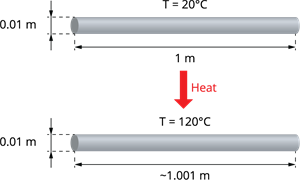PDF chapter test TRY NOW
Whenever we heat a solid, there is an increase in the dimensions of the body. It is known as the expansion of solids.
The solid undergoes three types of expansions.
- Linear expansions
- Areal expansions
- Cubical expansions
Linear expansions:
The increase in the length is proportional to the rise in temperature, original length, and material type. The amount by which the unit length of a material increases when the temperature is raised by one degree is called the coefficient of linear expansion. The coefficient of linear expansion is used to find out the actual increase in length. It can be represented by the symbol (alpha).
Consider a material with the length of at c and the material is heated up to c, now the length of the material is . Let be the coefficient of linear expansion, then we have:
---- eqn 1
The will vary for different materials.

Expansion in solids
In the above diagram,
= 1 m
= c
= c
= 1.001 m
then,
= 0.0000099.
We shall calculate the length after the expansion using equation,
We shall calculate change in length using equation,
Areal expansions:
The amount by which the area of a material increases when the temperature is raised by one degree is called the coefficient of superficial expansion.
The coefficient of superficial expansion can be designated by the symbol (beta).
Cubical expansions:
The amount by which the volume of a material increases when the temperature is raised by one degree is called the coefficient of volumetric expansion.
The coefficient of volumetric expansion can be represented by the symbol (gamma).
.
